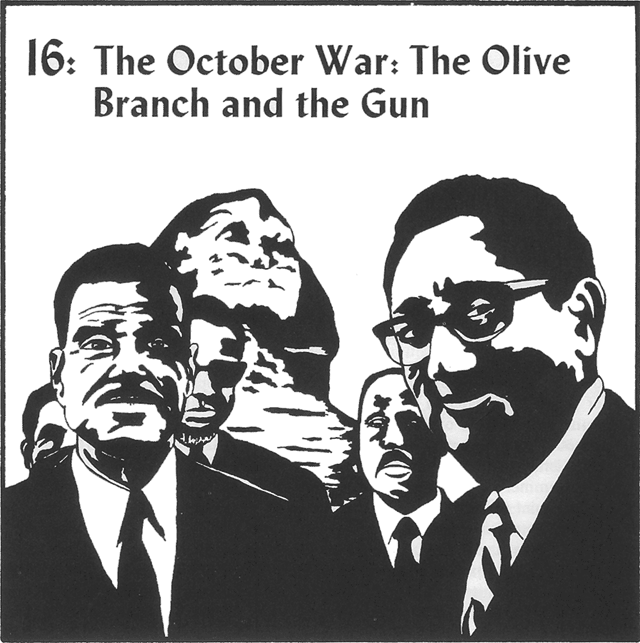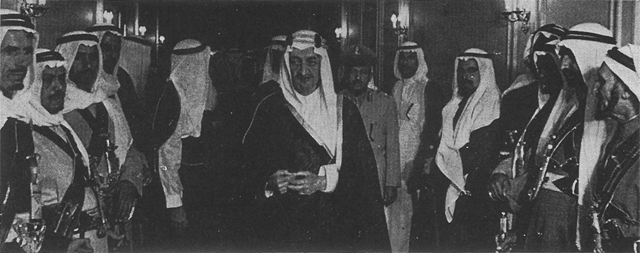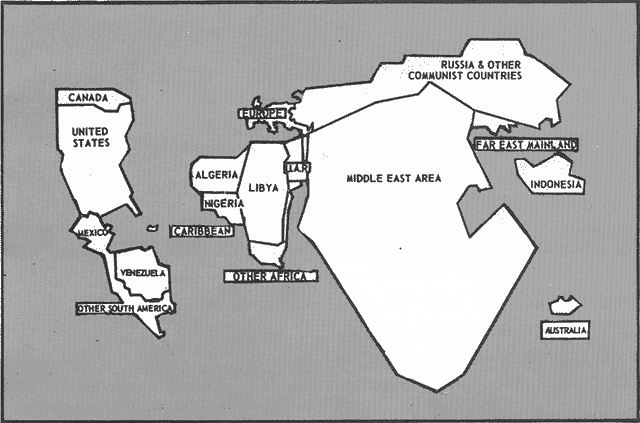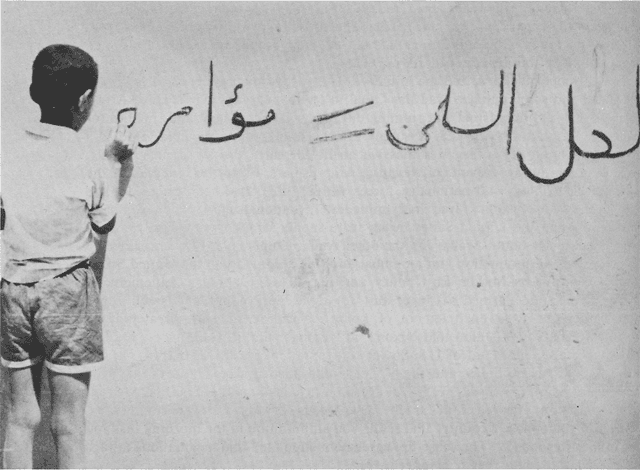Our Roots Are Still Alive - Chapter 16
Previous: Chapter 15
Table of Contents
Next: Chapter 17
New Jersey Solidarity-Activists for the Liberation of Palestine Main Site

- Washington is damned lucky to have Egypt, Syria and Saudi Arabia run for once by non-ideological, pragmatic men who've got their ducks in line. . . . They're about as conciliatory a bunch of Arab leaders as Washington could hope to find.
- Aide to U.S. Secretary of State Henry Kissinger
Since the death of Nasser in September of 1970, Anwar al Sadat, the new president of Egypt, had been making strong peace overtures to the United States. He believed that only the United States could pressure Israel to return occupied Egyptian land. At Nasser's funeral, he drew aside the American representative, Elliot Richardson, to assure him that Egypt planned to do all it could to implement the Rogers Plan. But Sadat was afraid that the United States had little inclination to push for a settlement since Hussein had expelled the fedayeen from Jordan and there was now peace on the Suez Canal front. If Sadat didn't recover Egypt's lost territory, he and the landowners and state officials that backed him could not hold power for long. The Egyptian people were demanding that he act.
In his first radio broadcast as president, Sadat pledged to the Egyptian people that 1971 would be "the year of decision" - the year in which Egypt would help get a just settlement for the Palestinians and get back Egyptian land from Israel, hopefully with American help. During that year he tried to please both his own conservative supporters and the U.S. government. He stopped land reform and ordered that all land redistributed to peasants in the past ten years be returned to the big landowners. He opened the country to investment from Western countries and allowed U.S. oil companies to explore for oil and build pipelines. He expelled the left opposition from his government and jailed many socialists, accusing them of an attempted coup.
As Sadat's new policies widened the already massive gap between rich and poor, strikes and demonstrations grew more frequent. Sadat finally turned the silenced guns of Egypt against the poor in late 1971. He sent troops and tanks against a militant strike of ten thousand workers at the giant Helwan Steelworks. The "year of decision" passed with no visible results. In January 1972, Cairo University erupted. Students fought a week-long battle with police and troops. It was the first in a series of demonstrations and strikes demanding fuller democracy, a cut in major government bureaucrats' salaries and the formation of popular militias to fight Israel.
Sadat moved even further to the right. While his troops crushed the student and worker protests, he patched up relations between Egypt and oil-rich Saudi Arabia, the staunchest Arab ally of the United States in the Middle East. He hoped that King Feisal would give him economic aid and urge the U.S. government to push for a peace settlement. But the United States did not respond.
In the summer of 1972, Sadat took a very dramatic step: he expelled the fifteen thousand Soviet military advisers from Egypt. He did not break relations with the Soviets completely, because he knew he would eventually need Soviet military aid if his peaceful overtures failed. But the expulsion was a clear signal to Washington. Sadat was ready to abandon Egypt's relationship with the Soviet Union and throw in his lot with the United States. He sent his diplomats to Washington to test the waters. They got an icy reception. A month later, Prime Minister Golda Meir of Israel paid a visit to the United States. She returned from her successful trip with promises of more Phantom jets for Israel's air force. Sadat concluded that only war could bring the necessary pressure for a settlement. He ordered his generals to prepare for a limited war.
Oil: The Vital Artery
At the same time powerful forces in the United States were pushing for a political settlement in the Middle East. For several years U.S. oil company executives had watched with alarm the growth of radical forces within OPEC, the Organization of Petroleum Exporting Countries. The oil companies could live with, and even profit from, the higher prices that OPEC members demanded. But with the U.S. driven out of Indochina, policy-makers feared that the more radical oil countries would follow Vietnam's example by reclaiming their resources. Some OPEC countries began to talk of nationalizing the oil companies and using the "oil weapon" against Israel and the United States.
 King Feisal of Saudi Arabia and his bodyguards
King Feisal of Saudi Arabia and his bodyguards
The U.S. government's support of Israeli expansionism was becoming a burden to the oil men. Even King Feisal of Saudi Arabia felt the pressure from the left. He was more and more isolated in his defense of the United States in OPEC meetings. A leading U.S. oil economist, Walter J. Levy, lamented:
- These are terrible, dangerous and difficult times. It is no longer just Arab against Israeli, it is Arab government against Arab government and Arab revolutionaries against Arab government.1
In May of 1973 an American oil executive gave President Richard Nixon and Henry Kissinger an urgent report from King Feisal: the Saudis could not "go it alone" in defending U.S. interests in the councils of OPEC and the Arab League.2 Feisal needed Arab allies. He could not get them as long as the United States continued to support Israeli occupation of Arab land. That August, Mobil Oil - a Rockefeller-controlled company - placed a full-page ad in major newspapers in the United States. The text declared, "It is time for the world to insist on a settlement in the Middle East."3
Henry Kissinger shared that view. As a long-time adviser to the Rockefellers before he became Nixon's National Security Adviser, Kissinger had learned well the importance of oil to the U.S. empire. As a leading American economist put it, oil was "the vital artery of the capitalist world." U.S. control of Middle Eastern oil was immensely profitable. It also gave the United States important leverage over Western Europe and Japan, countries which depended heavily on that oil. During the Vietnam war, those countries had grown stronger in their competition with the United States for markets. Controlling their economies through the flow of oil was now more important than ever. Henry Kissinger planned to work toward an Arab-Israeli settlement to keep Middle Eastern oil under U.S. control. But it would not be easy.
Kissinger's hands were tied in the early months of 1973. For twenty years one of the ways U.S. policy-makers had guarded oil interests in the Middle East was by backing Israel and encouraging Zionist efforts to build strong emotional support for Israel among the American people and Congress. Kissinger did not want to risk a major collision with Congress by suddenly pressuring Israel to withdraw from the occupied territories. He reportedly told a confidant, "I can't do anything until I have all the strings in my hand; and I won't have them in my hand until there is a crisis."4
 Geographical areas shown in proportion to oil reserves
Geographical areas shown in proportion to oil reserves
Anwar Sadat was, at that moment, preparing the necessary crisis. He was holding urgent meetings with President Hafez Assad of Syria, who was under strong pressure to recover the occupied Golan Heights. The two leaders were making final plans for a limited war against Israel on two fronts.
On October 6, 1973, Egyptian troops launched a massive surprise assault across the Suez Canal, and Syrian tanks and soldiers stormed into the Golan Heights. Well-trained and well-equipped Arab soldiers drove back the Israeli occupiers in the initial fighting. Even the fiercest critics of Sadat in Egypt were caught up for a few days in the elation that swept the Arab capitals. Egypt and Syria were at last fighting for their land - and winning!
Israel mobilized rapidly for the counterattack, expecting a quick victory. Instead, the fighting was intense on both fronts. Israel suffered thousands of casualties and lost large numbers of planes and tanks. As the fighting continued, Israel attacked the Syrian capital of Damascus. To punish the Syrians, Zionist leaders decided to reduce much of the Syrian economy to rubble. The Israeli air force bombed ports, factories, power plants and oil refineries throughout the country and government buildings in the capital. These attacks killed many civilians.5 As Israeli troops began to drive the Syrians back toward Damascus, the government formed popular militias to defend the city.
In Egypt Sadat ruled out mass mobilization. The Egyptian government told volunteers that their help was not needed and turned down offers of support from Algeria and Libya. Once his troops had set up their beachhead across the Canal, Sadat's limited war had served its purpose.
Israeli troops quickly seized the initiative. They drove the Egyptians back toward the Canal and some units crossed the Canal to try to encircle Egypt's Third Army. Even as they did this, Israel was running out of crucial equipment and supplies for its army. Without a quick U.S. re-supply effort, Israel's military would grind to a halt. The United States began a massive airlift to rearm the advancing Israelis.
This action outraged even conservative Arab leaders. From the outbreak of the war, the Palestinians and nationalist forces within OPEC had been calling for the use of the "oil weapon." Iraq had immediately nationalized U.S. oil company holdings. When the United States began to re-supply Israel, even Feisal of Saudi Arabia had to act. Saudi Arabia and the other Arab members of OPEC announced a 25 percent cut in production and an embargo on oil shipments to the United States until it changed its Middle East policy and helped bring about a settlement.
The oil embargo alarmed Kissinger. But worse was yet to come. The Israeli troops were completing their encirclement of Egypt's Third Army and threatening to destroy it. The Soviet Union told Nixon and Kissinger that it would take measures to prevent this. The threat of U.S.-Soviet confrontation was the last straw. On October 22, the United States and the Soviet Union pushed a cease-fire through the UN Security Council. Syria and Egypt accepted it quickly, and U.S. pressure eventually convinced the reluctant Israelis to agree to it. Moshe Dayan commented, "How can you oppose a country that sends you ammunition in the morning that you fire in the afternoon?"6 The cease-fire agreement stipulated that negotiations toward an overall settlement begin at once.
The U.S. Wins the War
The real victor to emerge from the October War was the U.S. empire. Even the oil embargo and subsequent "energy crisis" had helped the United States government and oil companies in the long run.7 The American oil companies reaped many of the benefits of the OPEC price hikes at the expense of Europe, Japan and other countries. Exxon's profits went up 59 percent in 1973. Saudi Arabia's income also grew, and it used some of the money to finance conservative forces in Syria and Egypt. American arms sales to the oil-rich countries skyrocketed, especially to Iran, which the United States was building up as policeman for the oil-producing Gulf area.
More importantly, Kissinger had his crisis and could now begin to pull the strings that eluded him before. The expense of the war set off a major economic crisis in Israel. Israel was going to need large amounts of American aid to survive. That aid meant more U.S. leverage on Israeli policy. In the twenty-five years of Israel's existence, the U.S. government had supplied it with $3 billion in grants and credits. Now the United States was considering giving $8 billion to the desperate Israelis over the next four years.
Henry Kissinger boarded a plane in December of 1973 for the first of his famous "shuttles" to the Middle East. His immediate goal was to see that Israel, Egypt, Syria and Jordan showed up at the U.S. - and Soviet-sponsored Geneva peace talks to begin discussing a settlement. The talks adjourned after only laying the groundwork for mutual troop withdrawals. The adjournment left Kissinger free to pursue his long-term strategy of "step-by-step diplomacy," dividing the Arab countries by holding separate negotiations between each of them and Israel.
 A Palestinian boy registers his rejection of a U.S. settlement. His wall-painting reads 'No to the Peace Resolution'
A Palestinian boy registers his rejection of a U.S. settlement. His wall-painting reads 'No to the Peace Resolution'
Kissinger's strategy had a fatal weakness; it ignored the Palestinians. He and his advisers had worried about them before the Geneva conference. One Washington diplomat warned:
- One thing we can't afford to do is to let the Palestinians come between us and the Arab governments at the peace table.8
The Palestinians understood that Kissinger planned to make peace at their expense. While the Arab states fought for limited gains in the October War, Palestinian organizations had called for a people's war against Zionism. They had argued at the OPEC meetings for the use of the "oil weapon." The Palestine National Front had successfully organized a strike among Arabs working in Israeli industries, paralyzing key sectors like construction. Once again the Palestinians alone had stood firmly against Israel and the United States and their long-term plans for the area. The Palestinians were not prepared now to sacrifice their revolution for the narrow interests of the Arab heads of state.
A Palestinian National Authority
In the months after the October War, Palestinian organizations had to confront the possibility of a peace settlement that would turn the West Bank and Gaza over to the harsh rule of King Hussein of Jordan. After much struggle and discussion, Fatah, the Democratic Front and other groups developed a strategy to guide the revolution through this difficult period.9 The PLO would call for the establishment of its own "national authority" - a Palestinian government - on any Palestinian land liberated from Israeli occupation. The PLO rejected Hussein's claim to the occupied territories. At the same time, the PLO would begin a diplomatic offensive to gain recognition as the "sole legitimate representative of the Palestinian people." The PLO could not allow Hussein or other Arab leaders to speak in the name of the Palestinians.
During the winter and spring before the Palestine National Council meeting, Palestinian leaders held meetings in the camps and cities to debate with people the pros and cons of setting up a national authority. The Palestine National Front and most of the people of the occupied territories, whose future was immediately at stake, endorsed the plan. Other Palestinians, especially refugees whose original homes in Palestine were inside Israel, feared that accepting a national authority in the territories might mean abandoning the long-range goal of establishing a democratic secular state in all of Palestine. PLO leaders insisted in many stormy debates that the acceptance of a national authority would only be a step in the total liberation of Palestine. But, they argued, it was an absolutely necessary step to take at this point to advance the revolution.
The Popular Front for the Liberation of Palestine emphasized the dangers of accepting the national authority. Its leaders argued that a national authority could only be granted in the context of an imperialist settlement, the kind of settlement likely to emerge from the Geneva Conference. Such a settlement would require the Palestinians to recognize the state of Israel and drop their long-term goal. The national authority might well end up as a demilitarized state, sandwiched between Israel and Jordan, rather than a base for carrying on the revolution. The Popular Front called for the PLO to reject the Geneva Conference and any settlement that might come out of it. In the months ahead it united with other groups to form the "Rejection Front" which opposed the PLO's going to Geneva.
Most PLO leaders argued that the PLO should not refuse in advance to go to a conference to which it was not even invited. Such refusal would just play into the hands of its enemies, who would offer to represent the Palestinians. The task for the movement was to ensure that only the PLO represented the Palestinian people at Geneva or elsewhere. The PLO had to define what kind of national authority it would accept and struggle to win it at any conference. Only in this way could the PLO avoid the traps laid by the enemies of the Palestinian people.
At the twelfth Palestine National Council meeting in June of 1974, all the resistance groups united to pass a ten-point program. It called for the creation of a "fighting national authority" on any Palestinian territory liberated from Israel and emphasized the PLO's commitment to the total liberation of Palestine. The PLO declared that it alone represented the Palestinian people, including those in the West Bank and Gaza.
No sooner had the National Council adjourned, than King Hussein challenged the PLO. He claimed to represent the million Palestinians living in Jordan and the half-million living in the West Bank. He demanded that Israel return the West Bank to Jordan in any peace settlement. Sadat of Egypt and King Feisal of Saudi Arabia backed Hussein. They knew that Israel would accept Jordan as a neighbor, but had sworn never to negotiate with the PLO.
Recognize the PLO!
In October of 1974 an Arab Summit Conference met in Rabat, Morocco. On the agenda was the question of who should represent the Palestinian people in any possible peace negotiations. On the eve of the conference, Yasser Arafat received a manifesto smuggled out of the occupied territories. The manifesto, signed by one hundred eighty leading Palestinian figures, proclaimed that the PLO, not Hussein, was the "sole legitimate representative of the Palestinian people." Given this development, Sadat and Feisal could not make their move to undercut the PLO. The Rabat Conference declared the PLO the "sole legitimate representative" of the Palestinians. Progressive and right-wing Arab leaders combined to present a motion to the United Nations, asking that the PLO be invited to address the UN General Assembly. The General Assembly issued an invitation.
On November 13, 1974, Yasser Arafat stood before the United Nations General Assembly as a representative of the Palestinian people. His speech had been hammered out by all forces in the resistance movement. He carefully reviewed the history of the exile of the Palestinian people and compared it to the histories of other peoples - especially Africans in Rhodesia, Southwest Africa and South Africa - who had fought for so many years against the oppression of their people by European settlers and Western corporations.
In the audience were delegates from many countries which had won their own independence in wars of national liberation. Arafat explained the goal of the democratic secular state and its roots in Palestinian history. He called on all Jews living in the state of Israel to join with the Palestinians in building a just society free of racism and discrimination. He ended by saying:
- I am a rebel and freedom is my cause. I know well that many of you present here today once stood in exactly the same adversary position I now occupy and from which I must fight. You were once obligated by your struggle to convert dreams into reality. Therefore, you must now share my dream .... Today I have come bearing an olive branch and a freedom fighter's gun. Do not let the olive branch fall from my hand.10
The countries of the United Nations voted one hundred five to four to recognize the right of the Palestinian people to self-determination and to grant the PLO observer status at the United Nations. Only Israel, the United States, Bolivia and the Dominican Republic voted against the resolution.

Yaser Arafat addresses the United Nations, November 1974.
In a wave of demonstrations and strikes coordinated by the Palestine National Front to coincide with the UN deliberations, the people of the West Bank poured into the streets for ten days of defiance of Israeli occupation. The slogans of the insurrection clearly reflected the desires of Palestinians under occupation: "No to the Zionist occupation! No to the return of the West Bank to Jordan! Yes to the PLO - the sole legitimate representative of the Palestinian people!"
Shortly after the PLO won this diplomatic and political victory, its enemies launched new assaults against it. Smoldering conflict in Lebanon broke out into the open when the Phalangists, a right-wing Lebanese group which opposed the Palestinian presence in Lebanon, attacked a bus full of Palestinians and killed twenty-six people in April of 1975. The resistance organizations fought back against the Phalangists. The battles escalated into a war that soon engulfed all of Lebanon.
While the Palestinians and Syria were preoccupied with the fighting in Lebanon, Kissinger mounted a final, concerted drive for a settlement between Egypt and Israel. In September of 1975 Egypt and Israel signed the Sinai Accords. Under this plan Israel returned part of the Sinai to Egypt. In exchange for its territory, Egypt signed a series of non-aggression pledges. Israel's public reward was a $2.2 billion aid package from the United States, which would be renewed each year. The package included the delivery of F-16 fighter planes which were capable of carrying nuclear warheads. Newspapers later revealed Kissinger's private assurances to Israel: the United States agreed not to pressure Israel to negotiate with Syria or the PLO.
For its part, Egypt received a half-billion dollars from the United States. In signing the accords, Egypt accepted the presence of U.S. "technicians" in the Sinai passes to guarantee the treaty. The Palestinians immediately understood the immensity of Sadat's betrayal. With one stroke of the pen he had withdrawn Egypt from the "confrontation states" with Israel, leaving Syria and the Palestinians isolated. He had allowed American personnel to be stationed on Arab land, and he undermined the Arab unity against Zionism which had been built over the previous thirty years - one of the strongest weapons the Arabs had to offset the immense military might of the United States and Israel.
The PLO broadcast that Egypt had passed the "keys of war and peace" to Israel and the United States. Under attack militarily in Lebanon and politically in Egypt, the Palestinians had to rely increasingly on their own strength. While resistance fighters shouldered their guns in Lebanon, Palestinians in the occupied territories and inside Israel itself took up the struggle with a new intensity.
Footnotes
- Mid East Report, 21 June 1970, cited by Freed, War in the Mid East, p. 98.
- MERIP staff, "Open Door in the Middle East," MERIP no. 31, p. 5.
- Christian Science Monitor, 20 August 1973, cited by Barry Rubin, "U.S. Policy January - October 1973," Journal of Palestine Studies, vol. 3, no. 2 (Winter 1974), p. 102.
- John Galvani, Peter Johnson and Rene Theberge, "The October War: Egypt, Syria, Israel," MERIP no. 22, p. 20.
- Ibid., p. 14.
- New York Times, 1 November 1973, cited in MERIP no. 31, p. 6.
- For a general source on the effects of the oil embargo see Michael Tanzer, The Energy Crisis (New York: 1974).
- Washington Post, 29 October 1973, cited in MERIP no. 31, p. 6.
- For a general source on the debate in the resistance movement see Palestinian Leaders Discuss: New Challenges ,for the Resistance (Beirut: 1973).
- Yasser Arafat, Palestine Lives! (San Francisco: 1976), pp. 20-21.